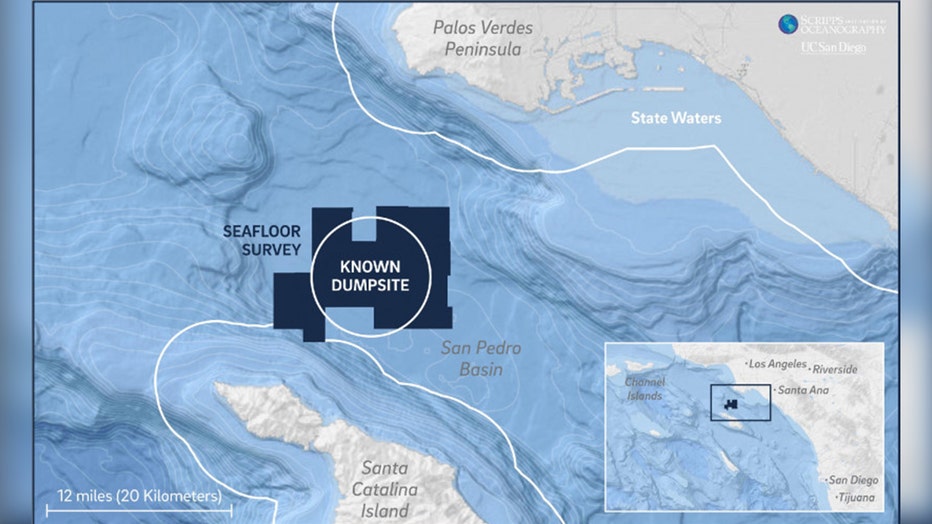Toxic dump site on ocean floor between Long Beach, Catalina Island much bigger than scientists expected
LOS ANGELES - A group of Scripps researchers who spent two weeks mapping the ocean floor between Catalina Island and Long Beach found that the massive toxic dumpsite previously discovered on the seafloor was much bigger than expected.
UC San Diego’s Scripps Institution of Oceanography mapped more than 36,000 acres of seafloor between Catalina Island and Long Beach, which was previously found to contain high levels of the toxic chemical DDT in sediments and the ecosystem.
DDT is a powerful pesticide that was banned from use in the U.S. in 1972 due to its adverse environmental effects, such as those to wildlife, as well as its potential human health risks.
The survey conducted on the Sally Ride, one of the most technologically advanced research ships in the country, identified an excess of 25,000 barrels believed to contain high levels of DDT and an excess of 100,000 total debris objects on the seafloor, according to their findings released Monday. Researchers noted that the actual number of barrels could be much higher because the marine robotic technology might not have counted all items due to how deep they were deposited in the sediments, or deterioration of the material.

Scripps Researchers will use the Sally Ride, one of the most technologically advanced research ships in the country, to survey the seafloor for the discarded waste.
"The target locations are consistent with the previously identified dumpsite and extend much further than we expected," said Eric Terrill, chief scientist of the expedition and director of the Marine Physical Laboratory at Scripps Institution of Oceanography.
RELATED: Massive toxic dump site discovered on ocean floor between Long Beach and Catalina Island
"Unfortunately, the basin offshore Los Angeles had been a dumping ground for industrial waste for several decades, beginning in the 1930s. We found an extensive debris field in the wide area survey," said Terrill. "Now that we’ve mapped this area at very high resolution, we are hopeful the data will inform the development of strategies to address potential impacts from the dumping."
In 2011 UC Santa Barbara professor David Valentine discovered the toxic dump site while using a deep-sea robot. He saw at least 60 barrels filled with toxic chemicals leaking and littered across the ocean floor. This research prompted the Sally Ride expedition, which ran March 10-24, as a first step towards learning the true extent of the contamination.
Get your top stories delivered daily! Sign up for FOX 11’s Fast 5 newsletter. And, get breaking news alerts in the FOX 11 News app. Download for iOS or Android.
"There are several distinct track-line patterns in the surveyed area, suggesting that the dumping was repeatedly done from an underway platform such as a moving ship or barge," said Terrill. "Some of those lines are as long as 11 miles and approach state waters."

Barrels and targets of interest were found in nearly all areas of the 36,000 acres surveyed and extended beyond dumpsite limits, which is roughly 12 miles offshore Los Angeles, and eight miles from Catalina Island. Credit: Scripps Institution of Ocea
Researches noted that barrels and other items were found in nearly all areas of the 36,000 acres surveyed and extended beyond dumpsite limits, which is roughly 12 miles offshore Los Angeles, and eight miles from Catalina Island.
Terrill’s team is now working to finalize the release of the sonar data, which they hope will serve as a catalyst for an action plan and additional research endeavors to understand environmental impacts.
Senator Dianne Feinstein on Monday said the dumpsite is hurting marine life and could be a public health hazard.
"The expedition's findings confirm fears that a large number of barrels containing DDT-laced industrial waste were dumped off the coast of California and are now impacting marine life and potentially public health," said Feinstein, D-Calif.
"This expedition looked at just one of more than 10 total dump sites," she said. "Within the 36,000 acres examined, more than 25,000 barrels were identified, with tens of thousands of additional debris objects that could be more barrels. This is a massive and potentially very dangerous problem."
Feinstein released the statement after participating in a briefing with UC San Diego's Scripps Institution of Oceanography and scientists from UC Santa Barbara and San Diego State University.
"Simply put, this is one of the biggest environmental threats on the West Coast," the senator said. "It's also one of the most challenging because these barrels are 3,000 feet below the ocean's surface and there aren't many records of who did the dumping, where exactly it occurred or how many barrels were dumped."
Click here to read more.

